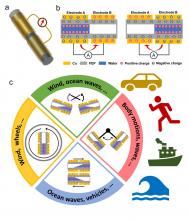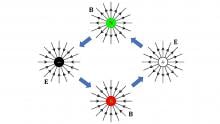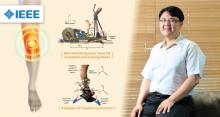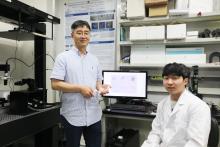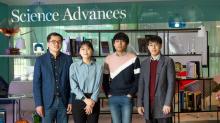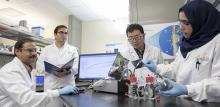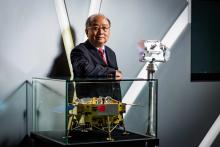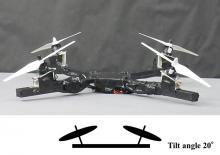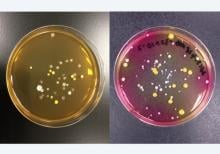Engineering & Technology Mechanical Engineering
News
23 Aug 2021
Dr. Hyunki Lee's team selected for developing a system that precisely measures human movements
12 Aug 2021
The Targeted Neuronal Network Regeneration research group from the Department of Robotics Engineering at DGIST was selected
28 May 2021
A reimagined robot hand combines strength with resilience, sidestepping the problems that accompany existing designs.
18 Mar 2021
A research team from the Faculty of Engineering of The Chinese University of Hong Kong (CUHK) has recently developed a water-tube-based triboelectric nanogenerator that can efficiently convert various irregular and low-frequency mechanical energies, including ocean wave energy, into electricity, providing a new avenue for the development of “blue energy”.
05 Aug 2020
Research at Kanazawa University as reported in Scientific Reports demonstrates atomic force microscopy imaging that gets around the challenges of exciting very small cantilevers at their high megahertz resonance frequencies. The approach accomadates wide frequency bandwiths, and is applicable for photosensitive materials in a wide range of liquids.
13 Jul 2020
A unique artificial intelligence approach is sifting through samples to find undiscovered fundamental particles that might clarify unexplainable physical phenomena.
13 Jul 2020
Acute kidney injuries can sometimes trigger the deterioration of small blood vessels and capillaries, leading to chronic kidney disease. But, this process is not completely understood. Now, for the first time, researchers from Daegu Gyeongbuk Institute of Science and Technology, Korea, in collaboration with teams from the University of Pittsburgh and University of Pittsburgh Medical Center, USA, have successfully used ultrasound super-resolution (USR) imaging to observe this process in live mice, revealing the promise of USR as a powerful diagnostic and research tool, and enhancing understanding of the disease.
06 May 2020
Scientists are finding safer ways to keep drug-loaded microrobots attached to cancer tissue.
06 Apr 2020
Two Kavli IPMU string theorists and a condensed-matter theorist have found a quantum mechanical anomaly in the duality between the electric field and the magnetic field, which could play a role in removing an inconsistency in string theory.
24 Oct 2019
By combining a compressive sensing algorithm with a digital holographic microscope, Prof. Shih-Chi CHEN of the Department of Mechanical and Automation Engineering, Faculty of Engineering, The Chinese University of Hong Kong (CUHK) and his research team have developed a high-speed imaging method. The new approach is able to produce two-photon microscopy images of a 3D sample in one second, which is at a speed three to five times that of the conventional point-scanning method. The research result has been published in the journal Optics Letters recently.
13 Oct 2019
Nanogenerator is a type of new technology that converts thermal and mechanical energy as produced by small-scale physical change into electricity. Its presence secures a stable and sustainable source of electricity that powers a wide range of small electronic devices equipped with a variety of features. A research team led by Prof. ZI Yunlong, Assistant Professor in the Department of Mechanical and Automation Engineering at The Chinese University of Hong Kong (CUHK), has recently developed a universal standardized method for evaluating the output capacity of nanogenerators. Compared with the conventional one, the new method can reflect the practical output capacity of the nanogenerator more accurately. This research will set an important foundation for the practical application and commercialisation of nanogenerators as an emerging energy harvesting technology. This research was published recently in the prestigious scientific journal Nature Communications (https://www.nature.com/articles/s41467-019-12465-2).
05 Sep 2019
A research team, affiliated with South Korea's Ulsan National Institute of Science and Technology (UNIST) has presented a system that can quantitatively complement the diagnosis of knee arthritis, which was performed only by x-ray and doctor’s judgment.
03 Sep 2019
DGIST Professor Hongsoo Choi’s team developed a biodegradable micro-robot that performs both drug release and hyperthermia treatment into a desired area. Improved drug treatment and opened a new path of future anti-cancer treatment.
27 Aug 2019
The School of Design and Human Engineering at South Korea's Ulsan National Institute of Science and Technology (UNIST) has been selected to lead the exterior styling of Hyundai Motor’s autonomous vehicles.
27 Aug 2019
A recent study, affiliated with South Korea's Ulsan National Institute of Science and Technology (UNIST) has reported a highly flexible Metal-Organic Framework (MOF) with the NPR property.
22 Aug 2019
Wearing a flower brooch that blooms before your eyes sounds like magic.
KAIST researchers have made it real with robotic muscles.

10 Jun 2019
Malaysia International Water Convention’s & Water Loss Asia’s 2-day conference will be held in Kuala Lumpur, Malaysia 1-3 October 2019.

17 Jan 2019
The Graduate School of Creative Design Engineering (CDE) at South Korea's Ulsan National Institute of Science and Technology (UNIST) has been invited to showcase its own style of art at the Dubai Design Week 2018, held in Dubai, United Arab Emirates.

26 Dec 2018
Do You Know How Robotics Can Bring Massive Improvement in Automation, Productivity and Innovation?

12 Dec 2018
Call for abstracts - deadline extended to 15 January 2019!
10 Dec 2018
Flexible skin for soft robots, embedded with electrical nanowires, combines conductivity with sensitivity within the same material.
10 Dec 2018
Helpful microbes inhale CO2 through a porous cylindrical electrode and exude useful chemicals.
10 Dec 2018
The Hong Kong Polytechnic University (PolyU) proudly supports the nation’s current lunar exploration, Chang’e-4 lunar probe, with advanced technologies.
05 Sep 2018
An improvement to the catalyst that converts methane to syngas could lead to a more economical process.

25 May 2018
South Korea's Ulsan National Institute of Science and Technology (UNIST) has signed MOU with UCSD, City of San Diego, and Ulsan City in furtherance to their mutual understanding to collaborate in the area of intelligent transportation sector.

14 May 2018
Advanced analysis of seismic data could lead the next wave in oil exploration.

03 Apr 2018
Improved diesel technology, combined with generally better fuel economy, has led to the widespread belief that diesel vehicles are more environmentally friendly than their petrol counterparts.
08 Feb 2018
Stability of unmanned aerial vehicles in heavy winds can be improved through rotor placement and angle, according to a team from Tohoku University and Kanazawa Institute of Technology.
01 Feb 2018
Skin squames are a source of food for the bacteria found in air-cooling units, which produce odours even in a dust-free air-conditioning system, a research by Hong Kong Baptist University scholars revealed.
Events
Sorry, nothing coming up for this discipline
Researchers
Sorry, nothing coming up for this discipline
Giants in history
Sorry, nothing coming up for this discipline


